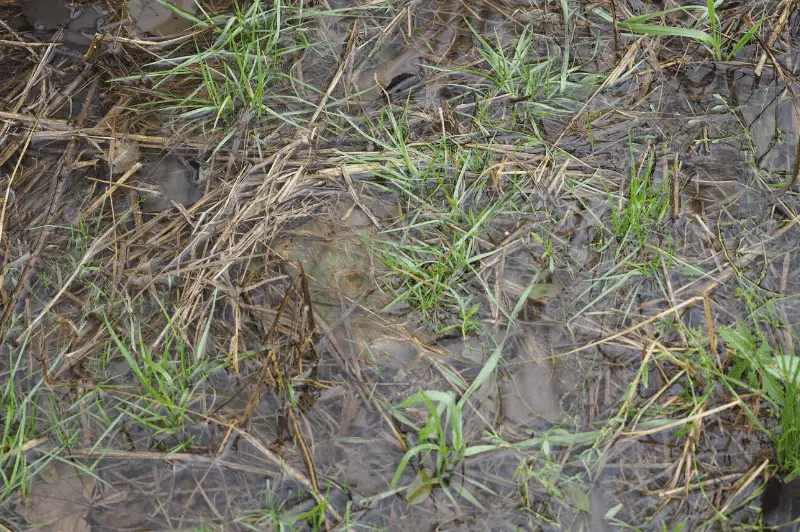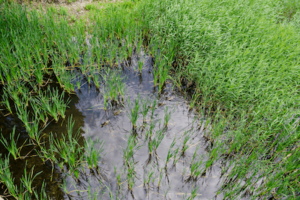Why is My Lawn Always Wet?
Does it seem like your lawn is always wet or has standing water? A wet lawn can mean that your animals and kids are always tracking mud into your house and your lawnmower is always getting clogged up with wet grass. Wet areas can also be a prime breeding ground for mosquitoes and other pests, making it nearly impossible for you to enjoy your yard.
So, why is your lawn always wet? There are several reasons why your lawn may be wet:
- Poor-planned landscaping
- Low areas that gather water
- Blocked drains or irrigation systems
- Moisture-retaining soil
- Not enough vegetation
- Too much shade
- Your home is causing standing water
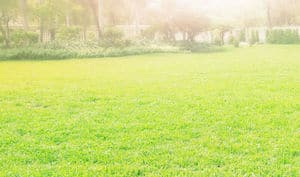
Once you understand why your lawn my be so wet all the time, it is easier to determine the culprit. Take time to assess your property to find the factors that may be causing your lawn to stay wet. Once you know why your lawn is wet, then you can take the proper steps to correct it. Keep reading to get a more in-depth look as to why your lawn is wet.
1. Wet Lawn Caused By Poor Planned Landscaping
When you plan to change the landscaping of your yard or add additional fixtures, like sheds, pools, or patios, it’s important to think about how the irrigation of your yard will be effecting. More times than not, people add these things to their landscaping to find out later that it is causing standing water in their yard.
Likewise, if you’re planning to landscape your yard, consider the amount of soil and vegetation you plan on moving. The less soil and vegetation you have, the more standing water you may get. Vegetation and soil work to soak up moisture, so when you remove it, the water doesn’t have anywhere else to go.
When you go to landscape your yard, you can add irrigation systems to help the water drain properly. This can help eliminate standing water and still allow you to add new fixtures to your yard.
Why landscape your yard to then cause standing water and a breeding ground for mosquitoes? Then, you wouldn’t even be able to enjoy the area you worked so hard to create. To learn more about how to keep pests like these away, visit our article How to Keep Mosquitoes Out of Your Yard.
If you’re going to change your landscaping you’ll need some tools to get started:
 2. Your Lawn Has Low Areas That Gather Water
2. Your Lawn Has Low Areas That Gather Water
Have you ever noticed how many ponds, lakes, and creeks tend to be at the bottom of a hill? Thanks to gravity, water will naturally irrigate and drain to the lowest area. If yard experiences standing water, it may be due to low areas in the yard where the rest of the water drains to.
Many people will build manmade ponds on their property to help drain water. The pond will be placed at the lowest part of their property. If you don’t like the idea of having a body of water on your property, you can avoid standing water by building up the low areas of your yard. By adding dirt and gravel, you make your yard level and eliminate standing water in certain areas.
3. Wet Lawn Caused By Blocked Drains or Irrigation Systems
Many yards will have irrigation systems already built-in, whether there’s a drain that helps move water away from your house or there are ditches that help to irrigate water downhill. Take time to notice whether your property has an irrigation system already in place.
If you are experiencing standing water in your yard, it could be due to blocked irrigation drains. A drain or a system that would usually remove water from your lawn is stopped up, causing water to sit over the surface of your lawn.
If you have irrigation ditches through your property, these can get blocked by grass clippings, sticks, trash from the road, and other debris. Luckily, these are easy to clear; all you have to do is remove the debris. When it comes to unblocking a drainage pipe, you may need a special tool to extend down the pipe to remove the blockage.
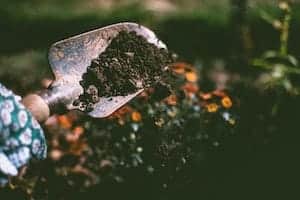
4. The Soil in Your Yard is Retains Moisture
Did you know that certain soil retains moisture more than others? If your lawn sprouts from a soil that has moisture-retaining properties, it makes it difficult for water to be absorbed down into the ground. If the soil in your yard has these qualities, It may take a few days after a steady rain before you see standing water start to disappear.
Clay soil is one of the main culprits for standing water. In the old days, people would use clay to seal off and insulate their homes; one reason they did this is that they figured out that clay does not let moisture in! Most of the Midwest region in America has an abundance of clay soil, which also causes this area to experience severe flooding.
One way you can help your soil become more absorbant to water is by tilling it up and adding dirt and sand. This will allow water to move freely through the soil and be absorbed quickly, so it’s not sitting over your lawn.
5. Wet Lawn Caused By Lack Of Vegetation
Is a large portion of your property covered by asphalt or by a patio? The run-off from this surface can cause standing water in your yard. One way to help rid your property of standing water is to add vegetation, especially around the areas that don’t have it.
All living things need water to survive, including plants. Plants can help absorb water into the soil so it doesn’t sit over your yard. You can landscape your patio to include areas of planted vegetation or remove a gravel area to plant grass. Plants are your friend when it comes to getting rid of standing water in your yard!
6. Wet Lawn Caused By Too Much Shade
While a shaded yard won’t cause standing water, it can cause moisture to stay on your grass for longer periods of time. If you have large trees in your yard, the trees can block the lawn from receiving the sun it needs to evaporate the moisture. A lawn that tends to hold moisture is also the breeding ground for many different lawn fungi and diseases. To know more, read our article Why Does My Lawn Have Mushrooms? Complete Guide.
Moisture on the grass can make it impossible to cut (read our article, as well as getting your feet wet any time you walk through the yard. If your yard is shaded, you may find that dew on the summer grass will stay there well into the afternoon before it starts evaporating. Using a reciprocating saw to cut limbs can help let sun light in on the lawn.
The obvious answer for this problem is to trim branches on your trees to allow more sunlight for your lawn. Not only will this help to dry the moisture from the lawn, but direct sunlight will also be healthy for the grass.
A saw will help eliminate unwanted limbs.
7. Your House is Causing Excess Water Moisture in Your Yard
Did you know that your house may be causing the standing water in your yard? The house is the peak fixture of any property, yet largely overlooked when it comes to solving lawn problems. If you are having trouble with too much moisture in your yard, it could mean that there is a problem with your house.
When you first notice standing water in your yard, the first place you should check is the gutters on your house. Gutters were created to move water away from your roof. The roof drains the water into gutters, the gutters transport the water to a drainage pipe, and the drainage pipe moves the water away from your house.
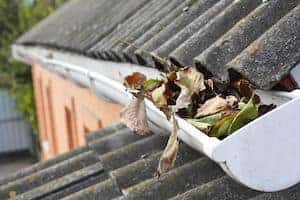
A broken or stopped-up gutter can cause standing water close to your house. This can cause severe structural damage to the foundation of your house, so it’s important to diagnose the problem quickly to keep it from happening.
Another way your home can affect standing water in your home is if a septic system isn’t functioning properly. Drainage fields of a septic system are known to flood and cause standing water if they aren’t working correctly. If you have a septic system, it’s important to know where the tank and drainage field is located so you can monitor the area for standing water.
I hope this article helped answer your questions about why you may have standing water in your yard. While you may be trying to remove moisture from your yard, a yard that is too dry does have some negative consequences, one of them being crabgrass. To learn more about crabgrass, you can read our article Getting Rid of Crabgrass Naturally: Everything You Need to Know.

